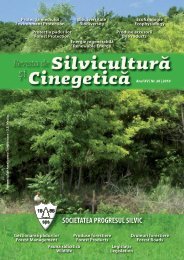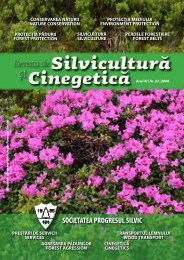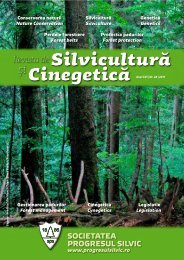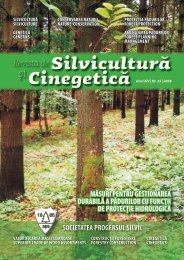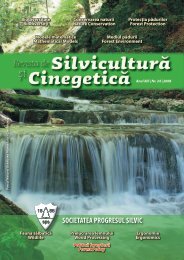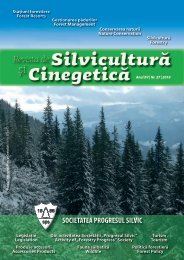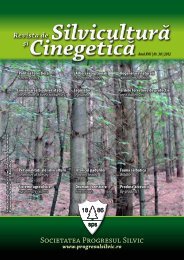Silviculture and Cinegetics Review - Societatea Progresul Silvic
Silviculture and Cinegetics Review - Societatea Progresul Silvic
Silviculture and Cinegetics Review - Societatea Progresul Silvic
Create successful ePaper yourself
Turn your PDF publications into a flip-book with our unique Google optimized e-Paper software.
FORESTRY BELTS SILVICULTURE AND CINEGETICS REVIEW XVII/30/2012<br />
Lilac (Syringa vulgaris) is resistant to frost <strong>and</strong> grows<br />
on soils with high calcium carbonate content, suckering<br />
strongly. Taking into account the especially decorative<br />
aspect <strong>and</strong> the dense shrubs, it is recommended to be<br />
planted on the side of the road belts.<br />
Smoke tree (Cotinus coggygria) develops very well on<br />
dry soils <strong>and</strong> even on limestone substrates. Although it<br />
supports shading fairly well, it is recommended mainly<br />
for the marginal rows of the forest belts, having an<br />
especially decorative aspect.<br />
Elm leaved spiraea (Spiraea x vanhouttei) was used in<br />
the marginal <strong>and</strong> post marginal rows of the road belts. It<br />
is not dem<strong>and</strong>ing to soils <strong>and</strong> it is resistant to frost,<br />
developing well especially on chernozems <strong>and</strong> alluvial<br />
soils. It shows an open temperament. Due to its dense<br />
shrubs <strong>and</strong> ornamental aspect, it may be planted in<br />
marginal brighter areas (having an open temperament)<br />
of the communication belts.<br />
Jasmin (Philadelphus coronarius) was used with good<br />
results in the marginal <strong>and</strong> post marginal rows of the<br />
road belts. It developed well on chernozems <strong>and</strong> alluvial<br />
soils. It is not dem<strong>and</strong>ing to soil, with the condition that<br />
it is not too dry. It resists well to frost. Being a dense<br />
ornamental shrub, it is usefully for the outer part of the<br />
communication paths protection forest belts.<br />
4. Conclusions<br />
- Protection forest belts express their multiple influences<br />
on the environment by reducing wind speed,<br />
temperature amplitudes decrease, reducing<br />
evapotranspiration, precipitation water accumulation,<br />
improved soil fertility <strong>and</strong> conservation, earlier entry<br />
into vegetation of crops, providing wood to the<br />
population in the area, providing berries, beekeeping<br />
development, increase of game, creating better working<br />
conditions, agricultural production increase, etc.<br />
- Carrying out with maximum efficiency of the forest<br />
belts’ protection function is determined by the<br />
composition, structure <strong>and</strong> their installation on the l<strong>and</strong>,<br />
elements that are conditioned, in their turn, by the<br />
natural circumstances in the region: general physicgeographical<br />
<strong>and</strong> phytoclimatic conditions <strong>and</strong> the<br />
intensity <strong>and</strong> direction of action of the harmful factors<br />
or climate adversity over which the forest belts act; at<br />
the same time, while exercising multiple functions:<br />
ecological, social <strong>and</strong> educational, when properly cared<br />
for <strong>and</strong> managed, they represent a renewable source of<br />
wood, berries, herbs <strong>and</strong> more.<br />
- Field, communication paths <strong>and</strong> anti-erosion<br />
protection forest belts show, for the most part, a good<br />
vegetative state <strong>and</strong> have a special role in reducing<br />
harmful of wind speed, increasing soil humidity in the<br />
agricultural l<strong>and</strong> <strong>and</strong> protecting crops from frost. These<br />
forest belts were made, both in the past <strong>and</strong> in recent<br />
years, mostly of black locust; for the forest belts with<br />
dual protection role (field <strong>and</strong> anti-erosion) were used as<br />
main species: grayish oak, Norway maple <strong>and</strong> field elm.<br />
- In the field protection belts development of the<br />
oleaster <strong>and</strong> dog rose was strongly constrained by black<br />
locust; in order to confer a proper structure <strong>and</strong><br />
efficiency to the forest belts it is necessary to use only<br />
helping species in the marginal rows (Tartarian maple,<br />
Turkestan elm, cherry-plum, osage-orange, etc.) <strong>and</strong><br />
shrubs (dog rose, hawthorn), black locust should be<br />
introduced in the interior rows (central core of the forest<br />
belt).<br />
- Communication protection belts were installed after<br />
1940 by using a rich assortment of species, depending<br />
on site conditions; tree species most frequently used<br />
were: field elm, Turkestan elm, ash, grayish oak,<br />
Norway maple, black locust, honey locust, mulberry,<br />
cherry-plum, Tartarian maple, ash-leaf maple, field<br />
maple, mahaleb cherry, osage-orange. Shrub species<br />
most frequently used were: hawthorn, dog rose, indigo<br />
bush, pea-tree, red dogwood, spindle-tree, Tartarian<br />
honeysuckle, blackthorn, privet, five stamen tamarisk,<br />
etc. In the border rows, towards the roads, ornamental<br />
shrub species were used, such as: lilac, elm leaved<br />
spiraea <strong>and</strong> jasmin.<br />
- Protection forest belts of communication paths against<br />
heavy snows, by their exceptional functional value but<br />
also their richness <strong>and</strong> floristic diversity, even as they<br />
are now in an advanced state of decay, are of a special<br />
ecological, social <strong>and</strong> economical importance, which<br />
requires, case by case, for the most par of them, urgent<br />
measures of improvement or rehabilitation.<br />
- Analyzed anti-erosion protection forest belts have a<br />
good crop development <strong>and</strong> have a special role in<br />
dissipating surface leakage, increase infiltration of water<br />
in the soil <strong>and</strong> prevent soil erosion. These forest belts<br />
were made with basic species: grayish oak or black<br />
locust; mixture <strong>and</strong> help species: Norway maple, field<br />
elm, wild cherry field maple, Tartarian maple (<strong>and</strong> in<br />
the marginal rows cherry-plum); shrubs: hawthorn, dog<br />
rose, indigo bush, red dogwood.<br />
- For optimum efficiency throughout the entire period of<br />
their evolution, protection forest belts require close<br />
46



